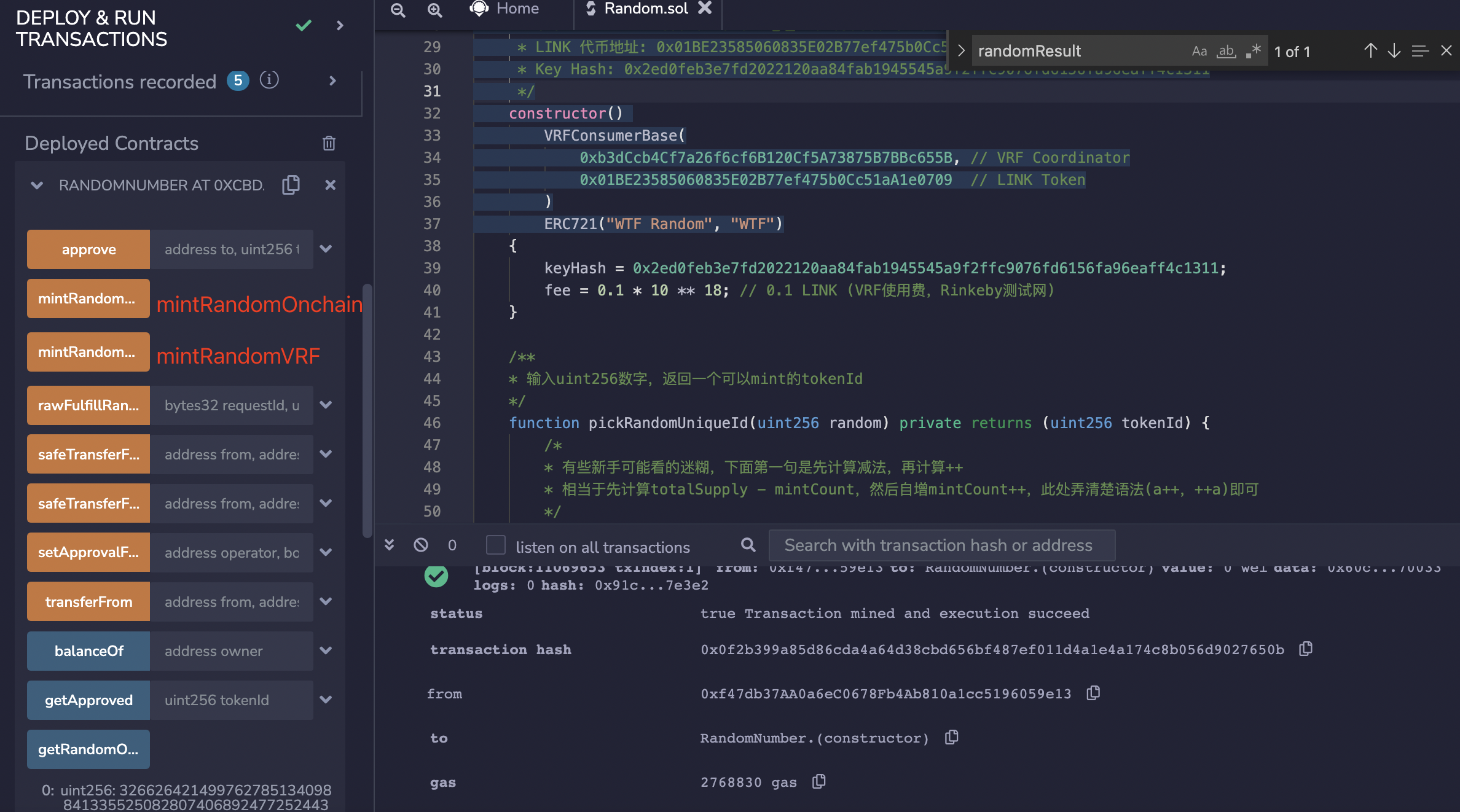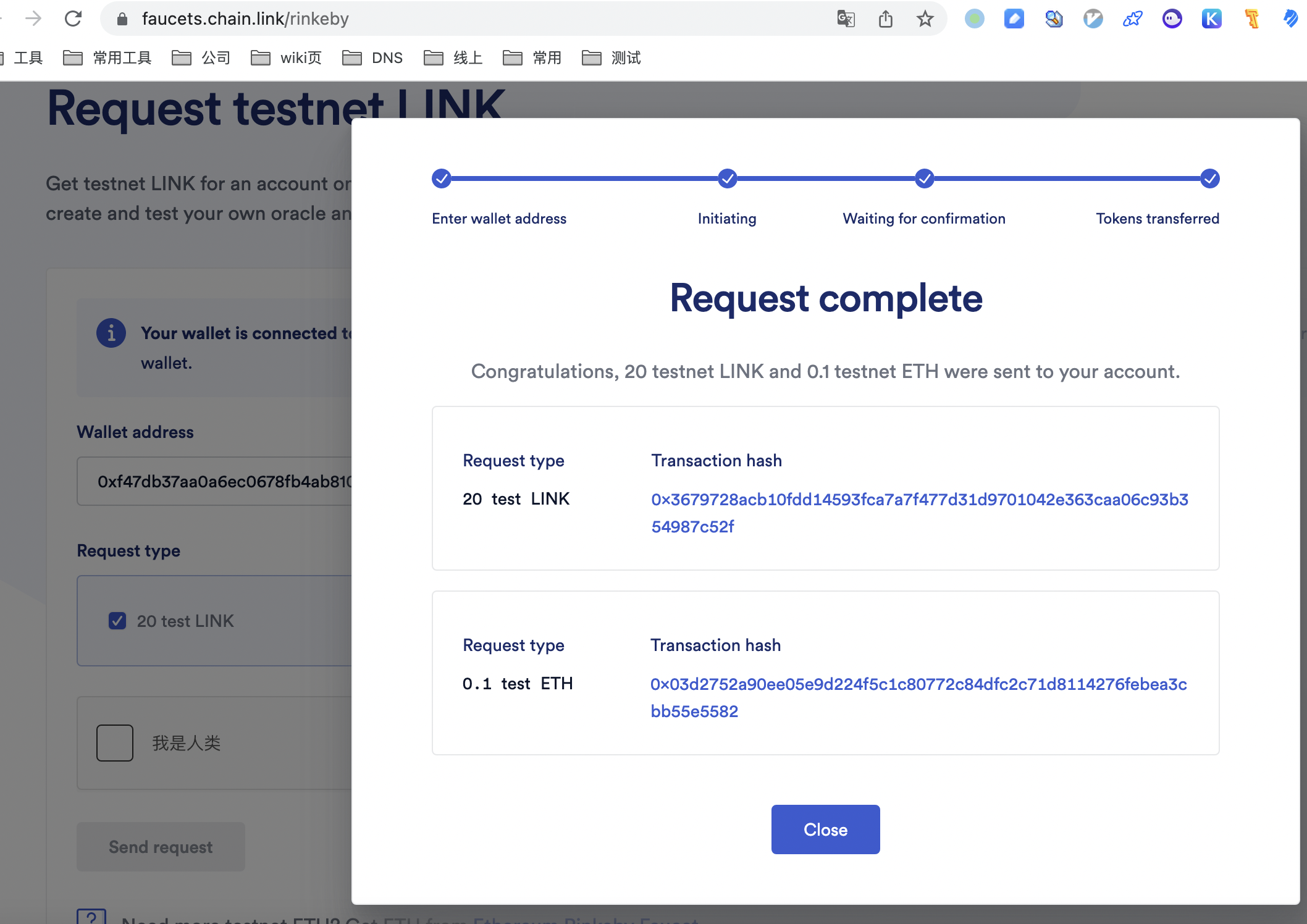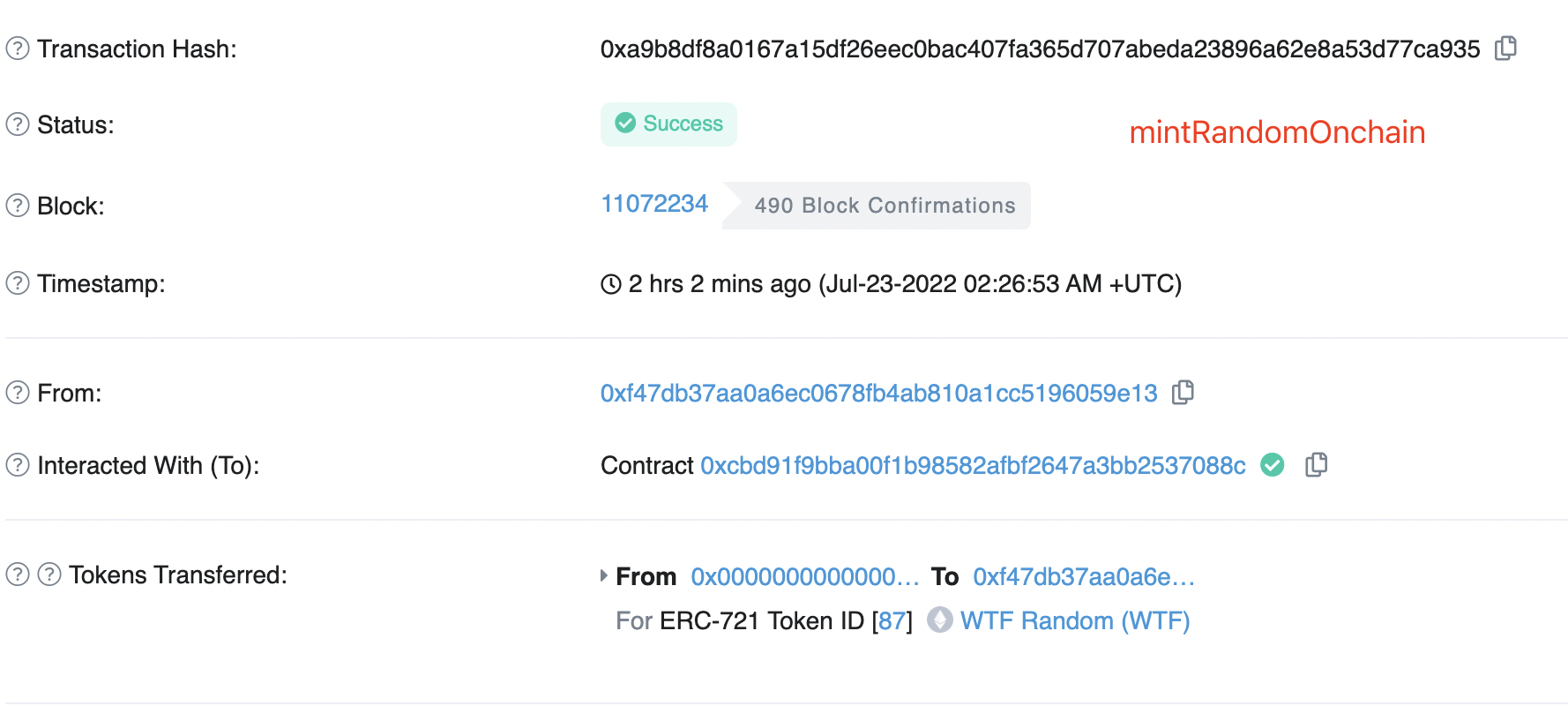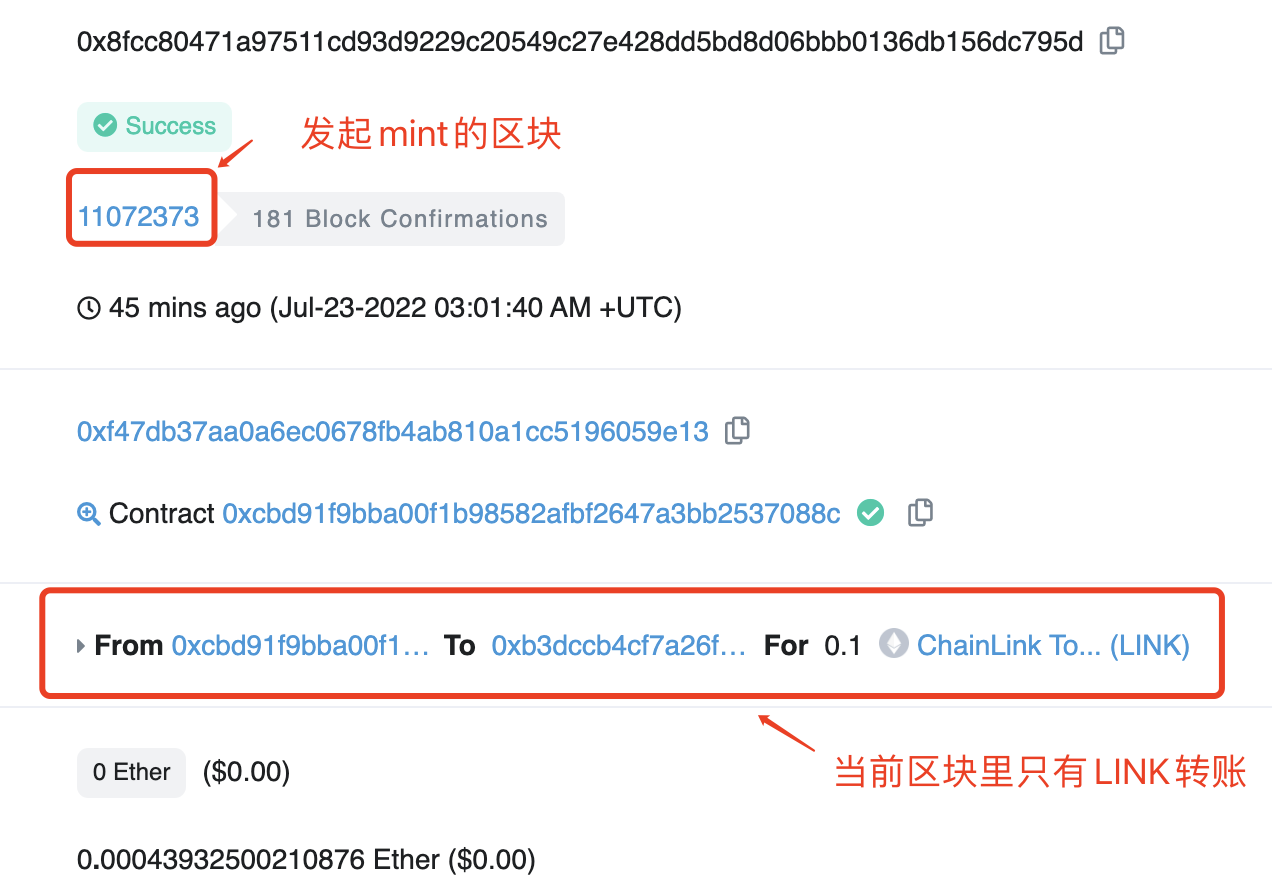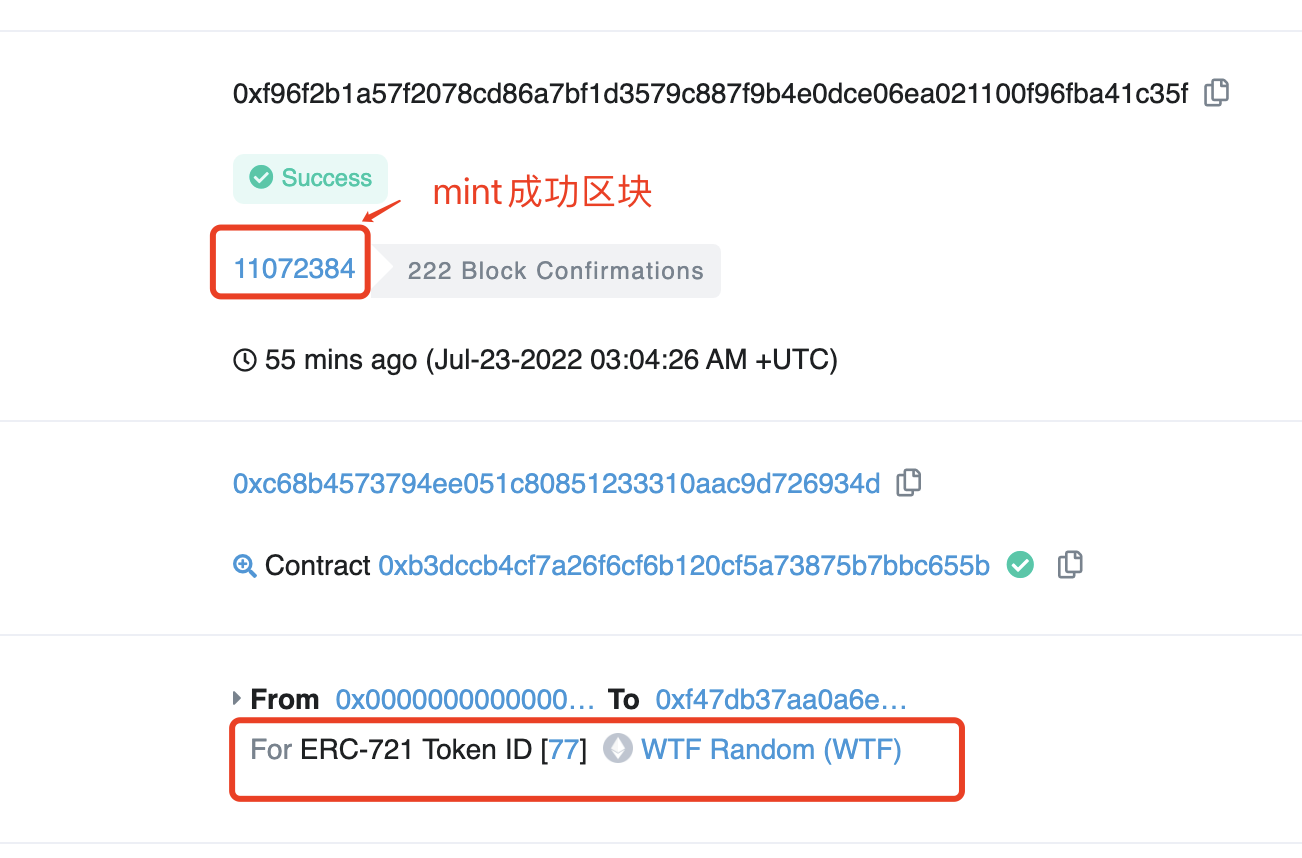| title | tags | ||||||
|---|---|---|---|---|---|---|---|
39. Chainlink Randomness |
|
I am currently re-learning Solidity to sharpen my skills and writing a "WTF Solidity Quick Start" guide for beginners to use (advanced programmers can look for other tutorials). I will update 1-3 lectures every week.
Twitter: @0xAA_Science
Discord: WTF Academy
All code and tutorials are open source on GitHub: github.com/AmazingAng/WTFSolidity
Many Ethereum applications require the use of random numbers, such as NFT random tokenId selection, blind box drawing, and randomly determining the winner in gamefi battles. However, since all data on Ethereum is public and deterministic, it cannot provide developers with a method of generating random numbers like other programming languages. In this tutorial, we will introduce two methods of on-chain (hash function) and off-chain (Chainlink oracle) random number generation, and use them to create a tokenId random minting NFT.
We can use some on-chain global variables as seeds and use the keccak256() hash function to obtain pseudo-random numbers. This is because the hash function has sensitivity and uniformity, and can generate "apparently" random results. The getRandomOnchain() function below uses the global variables block.timestamp, msg.sender, and blockhash(block.number-1) as seeds to obtain random numbers:
/**
* Generating pseudo-random numbers on the chain.
* Using keccak256() to pack some on-chain global variables/custom variables.
* Converted to uint256 type when returned.
*/
function getRandomOnchain() public view returns(uint256){
// Generating blockhash in Remix will result in an error.
bytes32 randomBytes = keccak256(abi.encodePacked(block.timestamp, msg.sender, blockhash(block.number-1)));
return uint256(randomBytes);
}Note: This method is not secure:
- Firstly, variables such as
block.timestamp,msg.sender, andblockhash(block.number-1)are all publicly visible. Users can predict the random number generated by these seeds and select the output they want to execute the smart contract. - Secondly, miners can manipulate
blockhashandblock.timestampto generate a random number that suits their interests.
However, this method is the most convenient on-chain random number generation method, and many project parties rely on it to generate insecure random numbers, including well-known projects such as meebits and loots. Of course, all these projects have been attacked: attackers can forge any rare NFT they want, instead of randomly drawing them.
We can generate random numbers off-chain and upload them to the chain through oracles. Chainlink provides a VRF (Verifiable Random Function) service, and on-chain developers can pay the LINK token to obtain a random number. Chainlink VRF has two versions. Since the second version requires registration on the official website and prepaid fees, and the usage is similar, only the first version VRF v1 is introduced here.
We will use a simple contract to introduce the steps to use Chainlink VRF. The RandomNumberConsumer contract can request a random number from the VRF and store it in the state variable randomResult.
1. The user contract inherits from VRFConsumerBase and transfers the LINK token
To use VRF to obtain a random number, the contract needs to inherit the VRFConsumerBase contract and initialize the VRF Coordinator address, LINK token address, unique identifier Key Hash, and usage fee fee in the constructor.
Note: Different chains correspond to different parameters, please refer to here to find out.
In the tutorial, we use the Rinkeby testnet. After deploying the contract, users need to transfer some LINK tokens to the contract. Testnet LINK tokens can be obtained from the LINK faucet.
// SPDX-License-Identifier: MIT
pragma solidity ^0.8.21;
import "@chainlink/contracts/src/v0.8/VRFConsumerBase.sol";
contract RandomNumberConsumer is VRFConsumerBase {
bytes32 internal keyHash; // VRF unique identifier
uint256 internal fee; // VRF usage fee
uint256 public randomResult; // store random numbers
/**
* When using chainlink VRF, the constructor needs to inherit VRFConsumerBase
* Different chain parameters are filled in differently.
*Network: Rinkeby testnet
* Chainlink VRF Coordinator address: 0xb3dCcb4Cf7a26f6cf6B120Cf5A73875B7BBc655B
* LINK token address: 0x01BE23585060835E02B77ef475b0Cc51aA1e0709
* Key Hash: 0x2ed0feb3e7fd2022120aa84fab1945545a9f2ffc9076fd6156fa96eaff4c1311
*/
constructor()
VRFConsumerBase(
0xb3dCcb4Cf7a26f6cf6B120Cf5A73875B7BBc655B, // VRF Coordinator
0x01BE23585060835E02B77ef475b0Cc51aA1e0709 // LINK Token
)
{
keyHash = 0x2ed0feb3e7fd2022120aa84fab1945545a9f2ffc9076fd6156fa96eaff4c1311;
fee = 0.1 * 10 ** 18; // 0.1 LINK (VRF usage fee, Rinkeby test network)
}2. User requests random number through contract
Users can call requestRandomness() inherited from the VRFConsumerBase contract to request a random number and receive a request identifier requestId. This request will be passed on to the VRF contract.
/**
* Request a random number from the VRF contract
*/
function getRandomNumber() public returns (bytes32 requestId) {
// The contract needs to have sufficient LINK
require(LINK.balanceOf(address(this)) >= fee, "Not enough LINK - fill contract with faucet");
return requestRandomness(keyHash, fee);
}-
The
Chainlinknode generates a random number and a digital signature off-chain and sends them to theVRFcontract. -
The
VRFcontract verifies the validity of the signature. -
The user contract receives and uses the random number.
After verifying the validity of the signature in the VRF contract, the fallback function fulfillRandomness() of the user contract will be automatically called, and the off-chain generated random number will be sent over. The logic of consuming the random number should be implemented in this function.
Note: The requestRandomness() function is called by the user to request a random number and the fallback function fulfillRandomness() is called when the VRF contract returns the random number are two separate transactions, with the user contract and the VRF contract being the callers, respectively. The latter will be a few minutes later than the former (with different chain delays).
/**
* The callback function of the VRF contract will be automatically called after verifying that the random number is valid.
* The logic of consuming random numbers is written here
*/
function fulfillRandomness(bytes32 requestId, uint256 randomness) internal override {
randomResult = randomness;
}In this section, we will use on-chain and off-chain random numbers to create a tokenId randomly minted NFT. The Random contract inherits from both the ERC721 and VRFConsumerBase contracts.
// SPDX-License-Identifier: MIT
pragma solidity ^0.8.21;
import "https://github.com/AmazingAng/WTFSolidity/blob/main/34_ERC721/ERC721.sol";
import "@chainlink/contracts/src/v0.8/VRFConsumerBase.sol";
contract Random is ERC721, VRFConsumerBase{NFTrelatedtotalSupply: Total supply ofNFT.ids: Array used for calculatingtokenIds that can beminted, seepickRandomUniqueId()function.mintCount: Number of NFTs that have beenminted.
Chainlink VRFrelatedkeyHash: Unique identifier forVRF.fee:VRFfee.requestToSender: Records the user address that applied forVRFfor minting.
// NFT Related
uint256 public totalSupply = 100; // Total supply
uint256[100] public ids; // Used to calculate the tokenId that can be minted
uint256 public mintCount; // Number of minted tokens
// Chainlink VRF Related
bytes32 internal keyHash; // Key hash for Chainlink VRF
uint256 internal fee; // Fee for Chainlink VRF
// Records the mint address corresponding to the VRF request identifier
mapping(bytes32 => address) public requestToSender; Initialize the relevant variables of the inherited VRFConsumerBase and ERC721 contracts.
/**
* Using Chainlink VRF, the constructor needs to inherit from VRFConsumerBase
* Different chain parameters are filled differently
* Network: Rinkeby Testnet
* Chainlink VRF Coordinator address: 0xb3dCcb4Cf7a26f6cf6B120Cf5A73875B7BBc655B
* LINK token address: 0x01BE23585060835E02B77ef475b0Cc51aA1e0709
* Key Hash: 0x2ed0feb3e7fd2022120aa84fab1945545a9f2ffc9076fd6156fa96eaff4c1311
**/
constructor()
VRFConsumerBase(
0xb3dCcb4Cf7a26f6cf6B120Cf5A73875B7BBc655B, // VRF Coordinator
0x01BE23585060835E02B77ef475b0Cc51aA1e0709 // LINK Token
)
ERC721("WTF Random", "WTF")
{
keyHash = 0x2ed0feb3e7fd2022120aa84fab1945545a9f2ffc9076fd6156fa96eaff4c1311;
fee = 0.1 * 10 ** 18; // 0.1 LINK (VRF usage fee, Rinkeby test network)
}
In addition to the constructor function, the contract defines 5 other functions:
-
pickRandomUniqueId(): takes in a random number and returns atokenIdthat can be used for minting. -
getRandomOnchain(): returns an on-chain random number (insecure). -
mintRandomOnchain(): mints an NFT using an on-chain random number, and callsgetRandomOnchain()andpickRandomUniqueId(). -
mintRandomVRF(): requests a random number fromChainlink VRFto mint an NFT. Since the logic for minting with a random number is in the callback functionfulfillRandomness(), which is called by theVRFcontract, not the user minting the NFT, the function here must use therequestToSenderstate variable to record the user address corresponding to theVRFrequest identifier. -
fulfillRandomness(): the callback function forVRF, which is automatically called by theVRFcontract after verifying the authenticity of the random number. It uses the returned off-chain random number to mint an NFT.
/**
* Input a uint256 number and return a tokenId that can be mint
* The algorithm process can be understood as: totalSupply empty cups (0-initialized ids) are lined up in a row, and a ball is placed next to each cup, numbered [0, totalSupply - 1].
Every time a ball is randomly taken from the field (the ball may be next to the cup, which is the initial state; it may also be in the cup, indicating that the ball next to the cup has been taken away, then a new ball is placed from the end at this time into the cup)
Then put the last ball (still may be in the cup or next to the cup) into the cup of the removed ball, and loop totalSupply times. Compared with the traditional random arrangement, the gas for initializing ids[] is omitted.
*/
function pickRandomUniqueId(
uint256 random
) private returns (uint256 tokenId) {
// Calculate the subtraction first, then calculate ++, pay attention to the difference between (a++, ++a)
uint256 len = totalSupply - mintCount++; // mint quantity
require(len > 0, "mint close"); // all tokenIds are mint finished
uint256 randomIndex = random % len; // get the random number on the chain
// Take the modulus of the random number to get the tokenId as an array subscript, and record the value as len-1 at the same time. If the value obtained by taking the modulus already exists, then tokenId takes the value of the array subscript
tokenId = ids[randomIndex] != 0 ? ids[randomIndex] : randomIndex; // get tokenId
ids[randomIndex] = ids[len - 1] == 0 ? len - 1 : ids[len - 1]; // update ids list
ids[len - 1] = 0; // delete the last element, can return gas
}
/**
* On-chain pseudo-random number generation
* keccak256(abi.encodePacked() fill in some global variables/custom variables on the chain
* Convert to uint256 type when returning
*/
function getRandomOnchain() public view returns (uint256) {
/*
* In this case, randomness on the chain only depends on block hash, caller address, and block time,
* If you want to improve the randomness, you can add some attributes such as nonce, etc., but it cannot fundamentally solve the security problem
*/
bytes32 randomBytes = keccak256(
abi.encodePacked(
blockhash(block.number - 1),
msg.sender,
block.timestamp
)
);
return uint256(randomBytes);
}
// Use the pseudo-random number on the chain to cast NFT
function mintRandomOnchain() public {
uint256 _tokenId = pickRandomUniqueId(getRandomOnchain()); // Use the random number on the chain to generate tokenId
_mint(msg.sender, _tokenId);
}
/**
* Call VRF to get random number and mintNFT
* To call the requestRandomness() function to obtain, the logic of consuming random numbers is written in the VRF callback function fulfillRandomness()
* Before calling, transfer LINK tokens to this contract
*/
function mintRandomVRF() public returns (bytes32 requestId) {
// Check the LINK balance in the contract
require(
LINK.balanceOf(address(this)) >= fee,
"Not enough LINK - fill contract with faucet"
);
// Call requestRandomness to get a random number
requestId = requestRandomness(keyHash, fee);
requestToSender[requestId] = msg.sender;
return requestId;
}
/**
* VRF callback function, called by VRF Coordinator
* The logic of consuming random numbers is written in this function
*/
function fulfillRandomness(
bytes32 requestId,
uint256 randomness
) internal override {
address sender = requestToSender[requestId]; // Get minter user address from requestToSender
uint256 _tokenId = pickRandomUniqueId(randomness); // Use the random number returned by VRF to generate tokenId
_mint(sender, _tokenId);
}After the contract is deployed, copy the contract address, and transfer LINK to the contract address just as you would for a normal transfer.
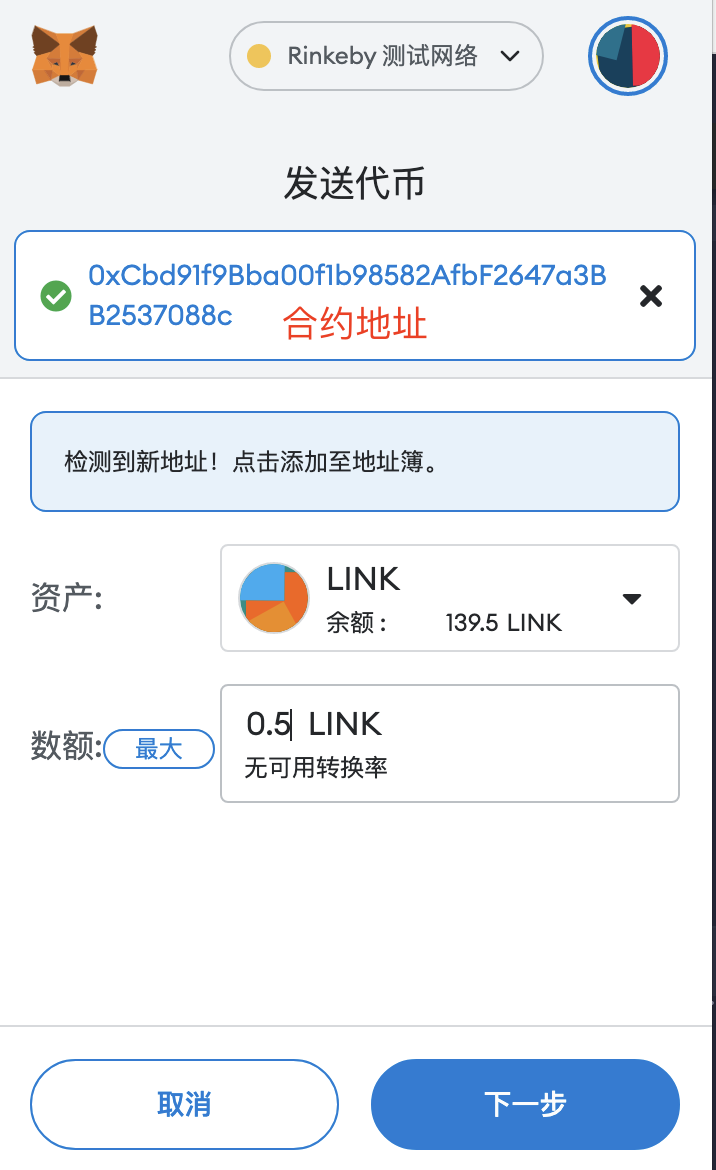
In the remix interface, click on the orange function mintRandomOnchain on the left side , then click confirm in the pop-up
, then click confirm in the pop-up Metamask to start minting the transaction using on-chain random numbers.
Similarly, in the remix interface, click on the orange function mintRandomVRF on the left and click confirm in the pop-up little fox wallet. The transaction of minting an NFT using Chainlink VRF off-chain random number has started.
Note: when using VRF to mint NFT, initiating the transaction and the success of minting is not in the same block.
From the above screenshots, it can be seen that in this example, the NFT with tokenId=87 has been randomly minted on-chain, and the NFT with tokenId=77 has been minted using VRF.
Generating a random number in Solidity is not as straightforward as in other programming languages. In this tutorial, we introduced two methods of generating random numbers on-chain (using hash functions) and off-chain (Chainlink oracle), and used them to create an NFT with a randomly assigned tokenId. Both methods have their advantages and disadvantages: using on-chain random numbers is efficient but insecure while generating off-chain random numbers relies on third-party Oracle services, which is relatively safe but not as easy and economical. Project teams should choose the appropriate method according to their specific business needs.
Apart from these methods, there are other organizations that are trying new ways of RNG (Random Number Generation), such as randao, which proposes to provide an on-chain and true randomness service in a DAO pattern.

